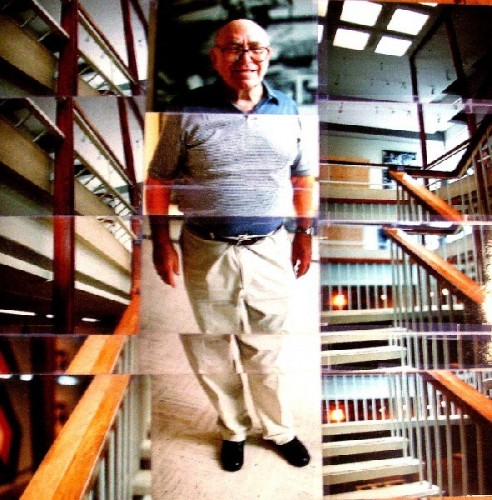Rose Art for Hire
Brandeis Plans to Parade the Relics
By: Charles Giuliano - May 29, 2010
Everyone knows the past couple of years have been brutal. When the DOW tanked it took a lot of us down from individuals on fixed income to universities and cultural institutions.
Brandeis University, my alma mater (Class of 1963), got slammed particularly hard. Many of its donors and big spenders were caught up in Bernie Madoff’s Ponzi scheme which targeted rich Jews in particular.
Among other draconian measures outgoing president, Jehuda Reinharz, some 17 months ago, proposed to close the Rose Art Museum and sell its collection.
The Rose was established in 1961. Its founding director, Sam Hunter, brilliantly gambled with some $45, OOO in seed money from the Mnuchin and Gervitz families to start a collection. Hunter might have bought one or two works by then A list artists. Instead he rolled the dice mostly in pop art, color field painting, and affordable abstraction. In all, he acquired a core of some 25 works.
Before the art market crash the collection of 7,500 objects was valued at $350 million. Of course that’s a misleading figure. A small portion of the holdings are worth in the millions each while many works are evaluated at considerably less.
What gives the Rose its particular status is its critical mass of major and mid level works and that it is indeed a collection. Many of the works acquire their status and value by the fact that they are a part of the vision and passion that went into their astute acquisition.
When collections are broken apart and sold the individual works are the equivalents of orphans.
One notable example of this would be the Gertrude Stein/ Alice B. Toklas collection. When Gertrude died Alice had no legal status in the estate. The heirs, relatives of Stein, swept in and cleared the walls. Alice was allowed to live in the Paris home they had shared but with nothing on the walls.
Some of the key works landed well. Picasso’s 1905/06 Portrait of Gertrude Stein ended up in the Alfred Stieglitz/ Georgia O’Keeffe collection. With other works it was left to the Metropolitan Museum of Art.
Picasso created Les Demoiselles d'Avignon in 1907.The other School of Paris masterpiece from 1907 was the Blue Nude by Matisse. Gertrude owned it and then it was bought by the sisters Etta and Claribel Cone. When these friends of Gertrude and Alice returned from Paris to Baltimore the collection came with them. At first they showed it in their home by appointment. Today the Cone Collection is owned by the Baltimore Museum of Art.
The Cone collection remained intact while the even greater Stein/ Toklas collection has been dispersed. There is no way today to appreciate in one space the great achievement of Gertrude Stein and her partner Alice B. Toklas. The legacy was scattered for the short term benefit of Stein’s greedy and short sighted heirs.
Even if we concede that president Reinharz was faced with a Solomon decision his career ends in disgrace. The university has been vilified by the academic and art world.
During the final days of his administration Reinharz, caving to professional, donor, and alumni pressures is attempting to broker a deal. Instead of selling the collection he is negotiating to rent it. Sotheby’s auction house is willing to serve as match maker between the university and potential renters.
Of course the Rose has always been willing to loan its collection to major museum exhibitions. It is the norm of the quid pro quo art world. In general there are fees to cover shipping and insurance. A museum may make money on these loans but it is not a strategy for fund raising.
Now and then, a museum which is in the midst of renovation, may organize a traveling show which raises money toward brick and mortar. Egypt is once again sending King Tut on tour.
During the middle ages this was known as Parading the Relics. It took as long as a century and considerable resources to build a great cathedral. It is a chicken and egg question as to which comes first: Great relics or a major cathedral?
Pilgrimages to the great cathedrals and their relics were an integral factor in the medieval economy. Chaucer’s Canterbury Tales, for example, is about a band of sinners traveling to Canterbury to pray over the bones of England’s greatest martyr/ saint Thomas Beckett. Of course they had a lot of fun along the way.
For the past month we have been on the contemporary art equivalent of a medieval pilgrimage. But instead of the bones of saints we have paid homage at Graceland, in Memphis, the Rothko Chapel in Houston, or the Chinati and Judd Foundations in Marfa, Texas. Like other pilgrims we leave our money behind at hotels, restaurants and shops. During medieval times one bought holy water while today it is mugs and t-shirts.
In the fall we would like to visit Dublin and London. Imagine if when I finally get to the library of Trinity College we find that the Book of Kells has been sold or is on extended loan to a Russian private collector.
Without the Rose Art Museum Brandeis is just another institution of higher learning. Nothing special.
Whatever Reinharz and his band of wheeler dealers can extract for the Rose collection it pales in comparison to its value a generation, two, or three from now. Great collections are also magnets for further giving.
It is daunting to consider the vast contemporary art collections of the alumni of Brandeis. A good portion of us share a passion for the arts. If only an increment of those works find their way to the Rose the result would be astonishing.
In the past I have given works to the Rose. There are some important pieces that I always thought would end up in the collection. Now, no way. Multiply that by thousands of alumni with similar feelings. And extrapolate that over coming generations.
It is the cultural equivalent of trying to cap the oil spill in the gulf. The humanistic loss is beyond calculation.









